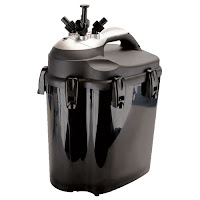Many other blogs have discussed (and will continue to discuss, I’m sure) the importance of testing various levels in your water and its effects on the overall health of your aquarium. But, how can you actually test it? For anyone who isn’t able to bring a water sample into That Fish Place or their local fish store for testing or who wants monitor their water quality at home, there are lots of options for what tests to use. While what to actually test for is for another blog, there are lots of options when it comes to how the tests are actually done. Here we’ll look at the pro’s and con’s of the three most common aquarium testing methods: Test Strips, Liquid Test Kits, and Electronic Testing Equipment. Read More »
Tag Archives: aquarium
Feed Subscription"Shocking" Christmas story
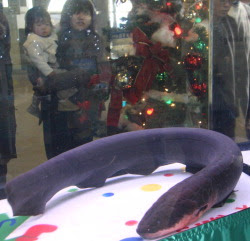 This week at the Aqua Toto Gifu aquarium in Japan, one of the coolest holiday Ideas I have ever seen was introduced to the public. The aquarium has on display, an electric eel in an aquarium that is actually powering lights on a near by christmas tree. In nature the eels have the ability to produce an electric current for the purpose of stunning near bye prey. The aquarium had the ingenious idea to use the eels natural electrical power for holiday cheer, and people are flocking to the aquarium to see this amazing display. The picture to the right was posted in the Mainichi Daily News in Japan.
This week at the Aqua Toto Gifu aquarium in Japan, one of the coolest holiday Ideas I have ever seen was introduced to the public. The aquarium has on display, an electric eel in an aquarium that is actually powering lights on a near by christmas tree. In nature the eels have the ability to produce an electric current for the purpose of stunning near bye prey. The aquarium had the ingenious idea to use the eels natural electrical power for holiday cheer, and people are flocking to the aquarium to see this amazing display. The picture to the right was posted in the Mainichi Daily News in Japan.
The aquarium has a copper wire installed into it, so that when the eel rubs up against the wire and produces an electrical current, the electricity travels from the aquarium to the light bulbs. Pretty neat trick
Maybe someday we will be driving around electric eel powered hybrid cars. HMMMM.
Just wanted to share that holiday story with you, until next blog
Dave
Oscar Fish Care
 I would like to welcome another guest blogger, Lexi Jones. Lexi is one of our staff marine biologists, and a Supervisor in our retail store fish room.
I would like to welcome another guest blogger, Lexi Jones. Lexi is one of our staff marine biologists, and a Supervisor in our retail store fish room.
Oscars can also become very aggressive and territorial, thus they are best kept alone or with other Oscars in a VERY large tank. However, if you insist on keeping a different species with them, you can try keeping other cichlids of a similar size like Texas cichlids or Jack Dempsey cichlids. Males, in particular, can fight each other for dominance in the aquarium, and it may lead to fatalities.
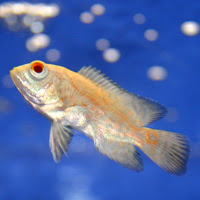
Product Spotlight: AquaEl Unimax Canister Filter
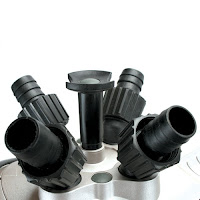
Another cool feature of the UniMax, are the multiple intakes and outlets on the two larger models. This gives you much improved water flow in larger tanks, versus models with only a single inlet and outlet.
The impeller design is also unique in the unimax, the impeller housing sits below the water level inside the canister, unlike most other units that have the impeller housing above the water level of the canister. This allows for easy priming of the filter, and extra quiet opperation. The Unimax models with multiple intakes and outlets, also use a multiple impeller design, which gives you a built in back up should one impeller be damaged, or stop functioning.
Species Profile: Giant Clams
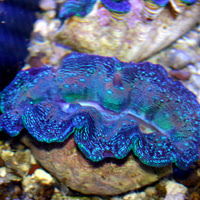
Just got back from MACNA XIX in Pittsburgh, and I would like to congratulate the Pittsburgh Marine Aquarium Society for hosting and outstanding conference.
The next few Blog topics will be about some of the Seminars and Events that I attended at this years MACNA conference.
One of the seminars that I found really interesting was the Giant Clam presentation by James Fatherree. James is the author of the book “Giant Clams in The Sea And The Aquarium”and gave a presentation based upon some of the most common questions that he is asked about Giant Clams, and the Answers to those questions.
How much light do I need to keep a Tridacna Clam? This is a question that I am commonly asked about clams from our customers here at TFP, and one of the questions that James Fatherree addressed during his presentation. How much light is needed is probably the most important question to be answered, in regard to keeping giant clams in the aquarium. Giant clams receive as much as 100 percent of their nutrition from light that provides energy for photosynthesis for their symbiotic algae (zooxanthellae). How much light depends much upon the species of clam that you are trying to keep. Clams are found in the oceans throughout a wide range of depths in the tropical Pacific Ocean, from near the oceans surface, down to more than 25 meters (83 feet). Some species are only found in fairly shallow water, like the Tridacna crocea, which require very intense lighting. Others Giant Clam species such as T. maximaand T. squamosa, are found at depths of up to 15 meters (50 feet) and required strong lighting. Another species of Giant Clam that is commonly kept in the aquarium trade, T. derasa, is found at depths of up to 25 meters (83 feet) and require moderate lighting. All these depths are extreme maximums, under ideal conditions. The vast majority of clams found in the wild are found at much shallower depths than these maximum. All species of Clams that are grown in commercial farms are typically grown in shallow pools or raceways under intense lighting.
The best answer to this question is that there is no such thing as too much light for Clams in the aquarium. Deeper water species, like Tridacna derasa and Hippopus hippopus, will tolerate fluorescent lighting in very shallow aquariums, or high output T-5, VHO, or Compact Fluorescent lighting in aquariums up to about 24” deep. All other clams should only be kept under the intensity of Metal Halide lighting. The deeper the aquarium the higher wattage metal halide light should be used, in general the more light you can provide, the higher your chances for long term health and growth.
For more great information on Giant Clams check out James Fatherree’s book “Giant Clams in The Sea And The Aquarium”
Hope this sheds some light on questions that you may have had about clams, until next time.
Dave
 That Fish Blog – Aquarium Advice and Information
That Fish Blog – Aquarium Advice and Information

